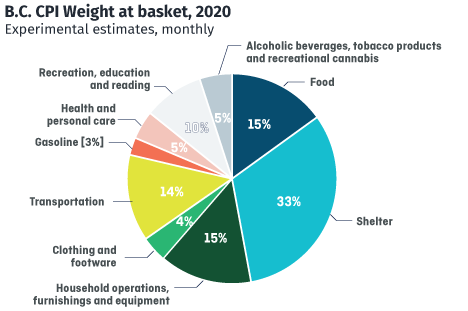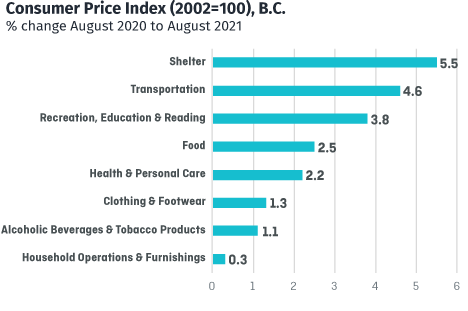“Inflation is a form of hidden taxation which is almost impossible to measure.”
John J. Beckley, US Politician, 1757-1807
What is inflation?
Inflation measures the rate of rising prices of goods and services in an economy. If inflation causes higher prices for necessities, such as food, it can have a negative impact on society. The Bank of Canada and the Government of Canada adopted an inflation-control target in 1991,1 which aims to keep total CPI (Consumer Price Index, a proxy measurement for inflation) at 1–3%. However, recent Statistics Canada data shows that Canada’s annual inflation rate jumped to 4.1% in August 2021 – the biggest increase since March 2003.
Interest rates are the primary tools by which to control inflation, and the Bank of Canada raises or lowers its interest rates to achieve the target inflation rate, typically within a horizon of 6 to 8 quarters – this is the time that it usually takes for policy actions to work their way through the economy and have their full effect on inflation. Inflation beyond a range of 2–3% is considered serious for numerous reasons. It typically has a regressive effect on lower-income families and residents living on fixed incomes. Inflation tends to redistribute wealth away from these groups to wealthier groups who can better hedge against inflation. It also increases the cost of borrowing for businesses and people, which in turn makes it harder for businesses to start and grow, and for people to access their own financing (such as mortgages).
Additionally, excessive inflation may lead to business uncertainty, reduced investment and savings, increased government spending, and even political and social unrest.

The CPI “Inflation Basket”
According to Statistics Canada, the goods and services in the CPI are divided into eight major segments: food; shelter; household operations, furnishings and equipment; clothing and footwear; transportation; health and personal care; recreation; education and reading; and alcoholic beverages, tobacco products and recreational cannabis.
Based on new national household spending data, the CPI basket weights have been updated and the biggest adjustment is housing – starting in June 2021, the national shelter component of CPI will represent 30.03% of the CPI basket weight (27.36% from 2017 onward).
[Year-over-year, overall inflation dropped to -0.3% in July 2020. It has since risen sharply, reaching 3.3% in August 2021. – need to get latest inflation stats from Fionn]


Graph 1 Sources: Basket Weights of the CPI, Statistics Canada. Graph 2 Sources: VEC Analysis; BC Stats
Deflation is the opposite of inflation – where the price of goods and services drop, often due to too many of those goods being available or when there is not enough money in circulation, or demand, to purchase those goods. However, excessive deflation also comes with negative economic effects: consumers and businesses restrict spending, leading to slower economic output, less investment and potentially deflationary spirals. A famous example is Japan during its “Lost Decade” (1991–2001).
Deflation has been increasingly discussed in conjunction with the potential impacts of various technological innovations, many of which have the potential to sharply decrease or decentralize the costs of developing, manufacturing and delivering goods, services, and information.
Stagflation refers to the phenomenon of slow economic growth (as measured by GDP) occurring alongside high unemployment and rising prices. In the early 20th century, dominant economic models found it difficult to explain circumstances that could leading to stagflation. However, an oil shock in the 1970s triggered stagflation in several developed market economies, including the US and UK, and since then, economists have posited various scenarios related to fiat (i.e. national) currency, economic policy, and oil prices.
Recently, stagflation has featured prominently in concerns about pandemic-related lockdowns slowing GDP, commodity constraints triggering higher prices, and increased money supply from government aid. However, other economists and representatives of central banks have repeatedly attempted to allay stagflation concerns.
Further Reading
- Understanding Inflation – Bank of Canada
- When Money Dies – Adam Fergusson
- Stagflation – Investopedia
[1] The target agreement has been renewed most recently in October 2016 for the five years to the end of 2021.
Source(s): Finances of the Nation, Government of British Columbia, Investopedia, Statistics Canada, Parliamentary Budget Office



